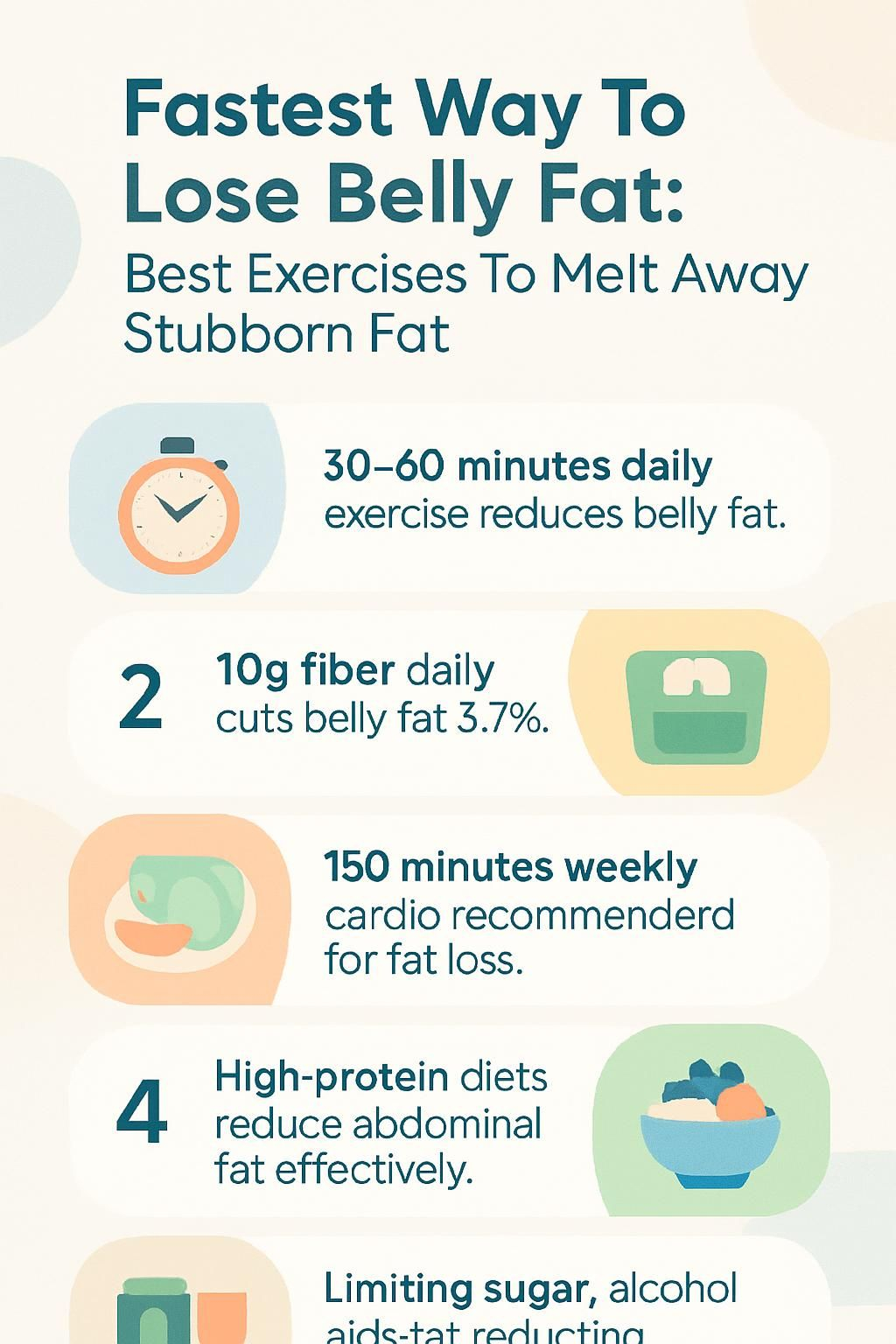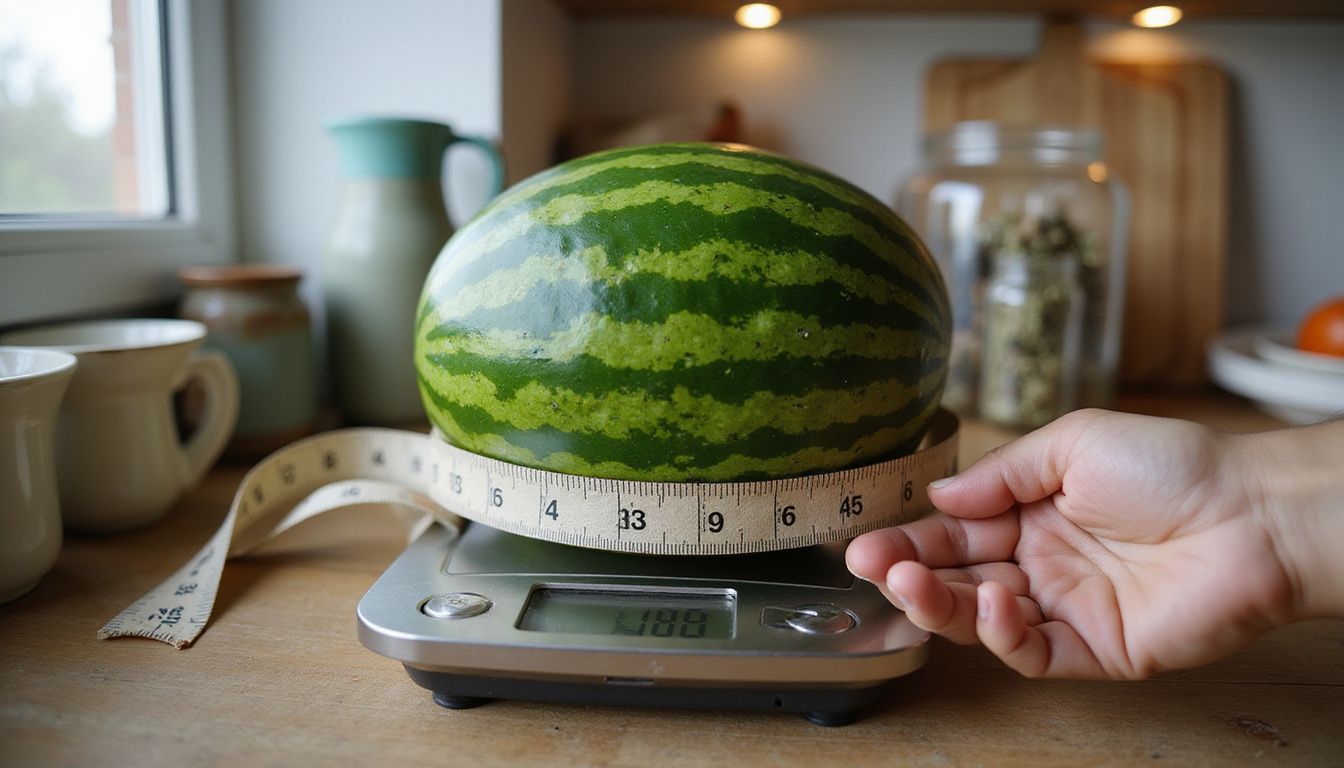Fastest Way To Lose Belly Fat: Best Exercises To Melt Away Stubborn Fat
Our Nutrition Assistant AI Suite will transform your body. You will lose fat, get toned, and build muscle. Gain confidence and optimal health.
If stubborn belly fat refuses to budge, you are not alone. Extra fat around your belly raises the risk of heart disease and type 2 diabetes. The best way to lose belly fat fast is a smart mix of healthy eating, targeted exercises to lose abdominal fat, and steady lifestyle habits.
This guide shares clear weight loss tips, science-backed strategies to help you lose fat, and the best workouts for trimming the midsection. Use these steps to build a slimmer waist and live a healthier life starting today.
Key Takeaways
- Combining a lower carb eating plan with 30–60 minutes of aerobic and strength training on most days reduces visceral belly fat more than either approach alone.
- Every extra 10 grams of soluble fiber per day relates to about a 3.7% drop in belly fat over five years, based on a study of 1,100 adults.
- Authorities such as Johns Hopkins and the CDC advise at least 150 minutes per week of moderate to vigorous cardio, like brisk walking or cycling, to help reduce belly fat.
- Higher protein intake preserves muscle during weight loss and is linked to greater cuts in abdominal fat compared with low-protein diets.
- Limiting sugary drinks and alcohol, tracking intake with apps, and eating probiotic foods such as yogurt support calorie control and visceral fat reduction.

Types and Health Risks of Belly Fat

Belly fat comes in two main types, subcutaneous and visceral. Subcutaneous fat sits under the skin. Visceral fat hides deeper in the abdomen and surrounds organs such as the liver, pancreas, and kidneys.
What is the difference between subcutaneous and visceral fat?
Subcutaneous fat is the soft layer you can pinch at the waist, arms, or thighs. Visceral fat sits behind the abdominal wall. You cannot see it, but it can expand your waist size and push inward on vital organs.
Visceral fat carries a higher health risk than subcutaneous fat. It is strongly linked to type 2 diabetes, heart disease, sleep apnea, fatty liver disease, and higher death rates. Tracking waist size can help you spot risk early and support healthy weight management.
What health problems are linked to excess belly fat?
Too much visceral fat relates to high blood pressure, abnormal blood fats, and insulin resistance. These changes raise the odds of heart disease, high blood sugar, type 2 diabetes, stroke, certain cancers, and fatty liver disease. A 2020 study tied both excess belly fat and high fructose intake to fatty liver development.
Women with larger waists often show higher cortisol, the stress hormone, which can drive more abdominal obesity over time. Poor sleep and reduced blood vessel function also appear more often with larger waistlines. Extra visceral adipose tissue raises long-term risk of early death compared with maintaining a healthy weight.
Big bellies can mean big trouble for your heart.
After a desk-bound year, my waist grew despite a stable scale number. A routine checkup flagged prediabetes. Shifting my diet and adding daily walks changed my labs and my midsection within months.
The Science Behind Losing Belly Fat
Fat loss depends on energy balance, how many calories you eat versus burn, and how your body stores fat. Diet and exercise change body composition, metabolism, and insulin action, which helps reduce belly fat.
Why is a caloric deficit important for fat loss?
Your body gains weight when calories in exceed calories out. A caloric deficit means you use more energy than you eat, so your body taps stored fat, including visceral fat, for fuel.
Create a deficit by reducing intake, raising physical activity, or both. Many people track food and activity with an app to stay in range. With age, muscle loss can slow metabolism. That makes strength work and mindful calorie control even more important.
Body mass index estimates size and health risk, but it does not cause fat loss. A consistent caloric deficit, supported by healthy habits, directly drives decreases in belly fat and total body fat.
How do diet and exercise affect belly fat?
Research from Johns Hopkins reports that lower carb diets often lead to greater early weight loss than low fat plans. Cutting processed foods and added sugars helps shrink fat stores, including the deep fat near organs.
Exercise burns calories and improves insulin sensitivity. That encourages your liver to use fatty acids from visceral fat. Studies show that combining aerobic exercise with resistance training leads to the largest drops in visceral fat, including among teens with excess weight.
People with prediabetes or type 2 diabetes can reduce belly fat and gain lean muscle with resistance training. In my case, brisk walks plus bodyweight moves trimmed my waist and boosted energy within six weeks.
Experts suggest 30–60 minutes of moderate to vigorous activity on most days to reduce belly fat and health risks.
Dietary Changes to Reduce Belly Fat
Food choices play a central role in reducing belly fat. Small changes add up when they improve fullness, limit calories, and steady blood sugar.
How does soluble fiber help reduce belly fat?
Soluble fiber absorbs water and forms a gel in the gut, which slows digestion. You feel full longer, and appetite often drops. Eating less across the day can create a natural calorie deficit.
A study of 1,100 adults found every 10 grams of soluble fiber per day was linked to a 3.7% decrease in belly fat over five years. Top sources include oats, barley, beans, lentils, apples, oranges, carrots, and broccoli.
High-fiber eating patterns support a healthier gut and better metabolic markers. A bowl of oatmeal with fruit or a cup of black beans at lunch keeps many people satisfied for hours without reaching for sweetened drinks.
Why should I limit processed and sugary foods?
Packaged snacks and fast options often contain trans fats, added sugars, and lots of salt. Trans fats, found in some margarines and older processed foods, raise inflammation and heart risk and can boost belly fat gain.
These foods are calorie-dense yet not very filling. That makes it easy to overshoot your calorie target. Sugary drinks, including fruit juice, relate to more abdominal fat and higher risk for type 2 diabetes, heart disease, and fatty liver. For example, 8 ounces of unsweetened apple juice has about 24 grams of sugar, close to many sodas.
Swap sugary drinks for water or unsweetened tea or coffee. Then add more protein to meals to support your plan to lose weight.
What are the benefits of high-protein meals for fat loss?
Protein increases feelings of fullness through hormones like peptide YY. It also helps keep muscle mass during weight loss, which protects your metabolism. Studies show higher protein intake helps people lose more fat and maintain results.
Good sources include eggs, fish, poultry, lean meat, dairy, whey, beans, and plant-based options. I replaced cereal with eggs at breakfast, and mid-morning snack cravings almost disappeared. Include a protein source at each meal to support abdominal muscles and help reduce belly fat.
How do refined carbs impact belly fat?
Refined grains digest quickly and spike blood sugar. That triggers more insulin, the storage hormone, which can direct more energy into abdominal fat depots.
Data from the Framingham study links higher whole grain intake to a 17% lower risk of excess abdominal fat. Processed refined products pack more calories and less fiber. That combination invites overeating and weight gain.
Limit white bread, pastries, and sugary cereals. In a busy season, I swapped snack bars for oats and brown rice. Within three months my belt size dropped, and afternoon energy slumps faded.
What healthy fats can help reduce belly fat?
After cutting refined carbs, favor healthy fats. Monounsaturated and polyunsaturated fats in olive oil, fatty fish, nuts, and seeds support heart and metabolic health. Eating salmon or sardines two to three times a week provides protein and omega-3 fats.
Omega-3s help lower inflammation and may reduce fatty liver risk in youth as well as adults. Algae-based omega-3 supplements can work for plant-focused eaters. Replacing trans fats with healthier oils supports arteries and veins while you trim abdominal tissue.
Effective Exercises to Melt Belly Fat
Movement is your fat-burning partner. Aim for at least 150 minutes each week. Some workouts use more muscles and oxygen, which helps you burn extra belly fat.
How do cardio workouts burn belly fat?
Cardio raises your heart rate and breathing, so you burn more calories. Aerobic exercise improves insulin levels and encourages the liver to use fatty acids from stored visceral fat.
A 2015 study in postmenopausal women found 300 minutes per week of aerobic exercise reduced body fat more than 150 minutes. Cardio also boosts blood flow to working muscles, which improves endurance and calorie use.
For best results, pair cardio with strength training. After adding 30–60 minutes of brisk walking or cycling most days, my waist trimmed down and my lung capacity improved.
What is HIIT and how does it help lose belly fat?
High-intensity interval training, or HIIT, alternates short, very hard efforts with brief rest. You can use sprints, fast cycling, or bodyweight drills such as mountain climbers.
Sessions often last 15 to 30 minutes. You burn calories quickly, and your body keeps burning extra for hours afterward. Studies show HIIT can raise metabolic rate and help reduce visceral fat while strengthening the heart.
Routines are easy to scale. Start slower, then build intensity over time for safe progress.
Can strength training reduce belly fat?
Yes. Lifting weights or doing resistance training builds lean muscle, which raises daily calorie burn even at rest. Research on teens with excess weight showed the biggest visceral fat drops came from combining strength work with cardio.
Health professionals often recommend two or more strength sessions per week. This is especially helpful if you have prediabetes, type 2 diabetes, or fatty liver disease. My clothes fit better within a month of lifting twice weekly, even when the scale barely moved.
What are the best core workouts for belly fat?
Crunches, planks, mountain climbers, and bicycle crunches train the abdominals and obliques. These moves build core strength and posture as you lower body fat through diet and cardio.
Use core training inside a HIIT or circuit session for efficiency. Combine with a lower carbohydrate pattern or a balanced plant-focused plan to target visceral fat more effectively.
How do plank variations target belly fat?
Side planks, forearm planks, and planks with leg lifts engage your entire core, including lower back and obliques. Longer holds or controlled leg lifts increase the challenge and endurance.
Planks alone do not melt fat. Paired with a caloric deficit, they improve muscle tone as fat layers thin. Modify the position to match your current fitness level.
Are bicycle crunches effective for belly fat loss?
Bicycle crunches target the rectus abdominis and obliques while raising heart rate. No equipment is needed, which makes them a simple add-on to any routine.
Use them in circuits or HIIT to increase calorie burn. Core training will not remove visceral fat on its own, but it can reveal definition as fat drops through diet and cardio. I saw better tone after adding three sets of 20 reps weekly alongside cleaner eating.
How do mountain climbers help reduce belly fat?
Mountain climbers are a total-body move that demand core stability and speed. Your heart rate spikes, so calorie use climbs fast.
Adding them to circuits helps burn more energy in less time. A 150-pound person can burn about 10 calories per minute with steady effort. They also build coordination and agility. Adjust pace and duration to fit your level.
Lifestyle Changes to Enhance Fat Loss
Daily habits make fat loss stick. Manage stress, prioritize sleep, and stay active to support your plan to lose weight and keep belly fat off.
How can managing stress help lose belly fat?
High stress raises cortisol, which can increase appetite and shift fat storage toward the abdomen. Research shows women with larger waists have higher cortisol spikes after stress events.
Practices like yoga, breathing exercises, and social support ease tension. Lower daily stress helps you avoid mindless eating and skipped workouts. Many people see steadier progress once stress is under control.
Why is restful sleep important for fat loss?
Short sleep raises the risk of weight gain and abdominal fat. In a study of 68,000 women followed for 16 years, sleeping under 5 hours per night increased weight gain risk compared with 7 or more hours.
Poor sleep disrupts hunger hormones and raises cravings for high-sugar foods. Sleep apnea is also linked to more visceral fat. Aim for a consistent bedtime, a dark cool room, and limited screens before bed.
How does staying active consistently affect belly fat?
Routine movement keeps insulin levels in a healthier range and encourages your body to use stored fat around organs. The CDC suggests 30 to 60 minutes of moderate or vigorous activity on most days.
Track activity to stay consistent and spot patterns. Regular exercise lowers the chance of chronic disease and shifts body composition toward more muscle and less fat.
Additional Tips for Faster Results
Small tools can speed progress. Use tracking, stay hydrated, limit alcohol, consider intermittent fasting, and include probiotic foods to support your gut.
How does tracking food and exercise improve fat loss?
Logging meals and workouts clarifies your caloric deficit. It also reveals hidden sugars and large portions. Research shows people who track tend to lose more weight and maintain new habits longer.
Apps provide quick nutrition data and keep you accountable. You can see if you hit protein goals, meet step targets, and keep fiber high. This awareness helps you make timely tweaks.
Why is hydration important for losing belly fat?
Water supports appetite control and metabolism. Many people confuse thirst with hunger, which can lead to overeating.
Replacing two daily sodas with water can save roughly 1,000 calories per week. Good hydration supports digestion, reduces bloating, and improves workout performance and recovery. Drinking water before meals may help reduce portion sizes.
How does limiting alcohol intake affect belly fat?
Alcohol adds empty calories that the body often stores as fat near the abdomen and liver. Heavy drinking is linked to more belly fat. People who limit intake to one drink per day tend to carry less abdominal fat than those who binge on occasion.
Alcohol can also lower self-control and boost appetite. Follow current guidance, up to two drinks per day for men and one for women. Cutting back often makes it easier to keep a caloric deficit and lose visceral fat.
What is intermittent fasting and does it help belly fat?
Intermittent fasting cycles feeding and fasting windows. Popular methods include 16:8 time-restricted eating and alternate-day fasting. These patterns may help regulate hunger hormones and improve metabolic health.
Some studies suggest fasting can reduce belly fat as effectively as daily calorie restriction and sometimes more, especially with enough protein. It does not fit everyone. Women with blood sugar concerns should talk to a clinician before trying it.
How do probiotic foods support belly fat loss?
Probiotics are helpful bacteria found in yogurt, kefir, sauerkraut, and kimchi. Certain Lactobacillus strains may support fat loss and better metabolic markers in people with excess weight.
Strain and dose matter. Adding probiotic foods is a simple way to support gut health alongside a balanced diet and regular exercise.
Combining Methods for Long-Term Success
Diet and exercise together form the core plan. Healthy fats, lean proteins, fiber, and movement work in concert to reduce stubborn belly fat.
How do diet and exercise work together to lose belly fat?
Smarter eating lowers the energy you store as fat. Cardio burns calories during and after workouts. Strength training protects muscle mass so more of the weight you lose is fat.
Studies from Johns Hopkins and others show that pairing a lower carb plan with consistent exercise improves weight loss more than diet alone. Combining aerobic and strength sessions produced the largest visceral fat drops in several trials, including research in teens with excess weight.
Healthy fats from seeds and nuts help you feel full, and protein guards muscle during a deficit. This combined approach also supports blood vessel health and reduces risks linked to sugary drinks and frequent alcohol use.
What habits help maintain belly fat loss long-term?
Consistency wins. Aim for 150 minutes of moderate or 75 minutes of vigorous exercise each week. Choose water over sugary drinks. Fill your plate with plants, lean proteins such as chicken or fish, and healthy oils, and watch portions when eating out.
Track progress with your waist size and how clothes fit. Prioritize 7–9 hours of sleep. Manage stress with short mindfulness sessions or evening walks. A supportive social circle helps you stay the course during busy weeks.
Frequently Asked Questions
Here are quick answers to common questions about exercises to lose belly fat, food choices, and timelines.
What is the best exercise for belly fat?
No single move erases belly fat. A mix of cardio, strength training, and core work is best. Studies show combining aerobic exercise with resistance training reduces visceral fat more than either alone.
Try brisk walking, jogging, cycling, or HIIT for calorie burn. Add two or more days per week of strength training for muscle maintenance. Core moves like planks, bicycle crunches, and mountain climbers add stability and strength to your midsection.
Can you lose belly fat in one week?
Large losses in a week are unlikely and often unsafe. Your body needs time to mobilize stored fat, especially around the abdomen.
Safe weight loss is typically one to two pounds per week. Rapid loss can harm health or cost you muscle. Set a clear calorie deficit, focus on protein and fiber, add daily movement, and limit alcohol. Progress builds steadily with consistent habits.
What are the top foods to burn belly fat?
Choose foods that support fullness and steady blood sugar:
- Soluble fiber sources: oats, barley, beans, lentils, apples, oranges, carrots.
- Protein: eggs, fish, poultry, lean meat, Greek yogurt, tofu, and beans.
- Fatty fish: salmon or tuna for omega-3 fats tied to lower visceral fat.
- Probiotic foods: yogurt or kefir to support gut health.
- Green tea: caffeine and EGCG may modestly increase calorie burning.
During a stressful stretch at work, Greek yogurt with nuts kept me full far longer than chips. Swapping refined snacks for produce and nuts supports fat loss and daily energy.
Conclusion
Losing belly fat takes steady effort, but it is achievable. Combine a calorie-controlled, protein-rich diet with regular cardio and strength training to reduce stubborn fat and maintain muscle. Keep processed snacks and sugary drinks to a minimum to help control calories and shrink the waist.
Target a waist under 35 inches for most women and under 40 inches for most men. Track habits, not just pounds. Looser clothing and a smaller waist often show progress before the scale does. If you have a medical condition, are pregnant, or take medications, speak with a healthcare professional before making major changes.
Stay active, sleep well, and manage stress. With consistent choices and the right exercises to lose abdominal fat, you can help reduce belly fat, support your heart, and feel stronger day to day.
FAQs
1. What is the fastest way to lose belly fat using exercise?
Research shows that a mix of aerobic activities and targeted movements, such as crunches, helps reduce abdominal fat most effectively. Aerobic activities burn calories, while crunches focus on strengthening the abdominal organ system and toning muscles in that area. Studies from the American Council on Exercise highlight that consistent aerobic exercise combined with core-focused movements leads to greater reductions in belly fat compared to either method alone.
2. Are crunches effective for melting away stubborn belly fat?
Crunches strengthen abdominal muscles and improve core stability, but they do not directly burn fat from the stomach area alone. Fat loss occurs throughout the body as a result of a calorie deficit created by diet and exercise. A 2011 study published in the Journal of Strength and Conditioning Research found that crunches alone did not significantly reduce abdominal fat, but they did increase muscle endurance in the abdominal organ system.
3. How does diet impact belly fat loss, and what foods should I eat?
Diet plays a key role in reducing belly fat. Consuming nutrient-rich foods, such as nuts, fruits, and vegetables, supports weight loss by providing essential nutrients and promoting satiety. Nuts, for example, are high in healthy fats and protein, which help control hunger and support muscle maintenance during weight loss. Data from the Harvard School of Public Health suggests that replacing processed snacks with nuts and fruits can improve overall body composition.
4. Can targeting specific organs help with losing belly fat?
Targeting specific organs through exercise is not possible; however, strengthening the abdominal muscles supports better posture and core function. Fat loss occurs systemically, not just in one area. Engaging in full-body workouts and maintaining a balanced diet with nuts and fruits helps reduce overall body fat, including in the abdominal region.
Summary: Combining aerobic activity with crunches and a diet rich in nuts and fruits supports healthy weight loss and strengthens the abdominal organ system. Evidence shows that spot reduction is not effective, but a holistic approach yields better results for losing stubborn belly fat.







